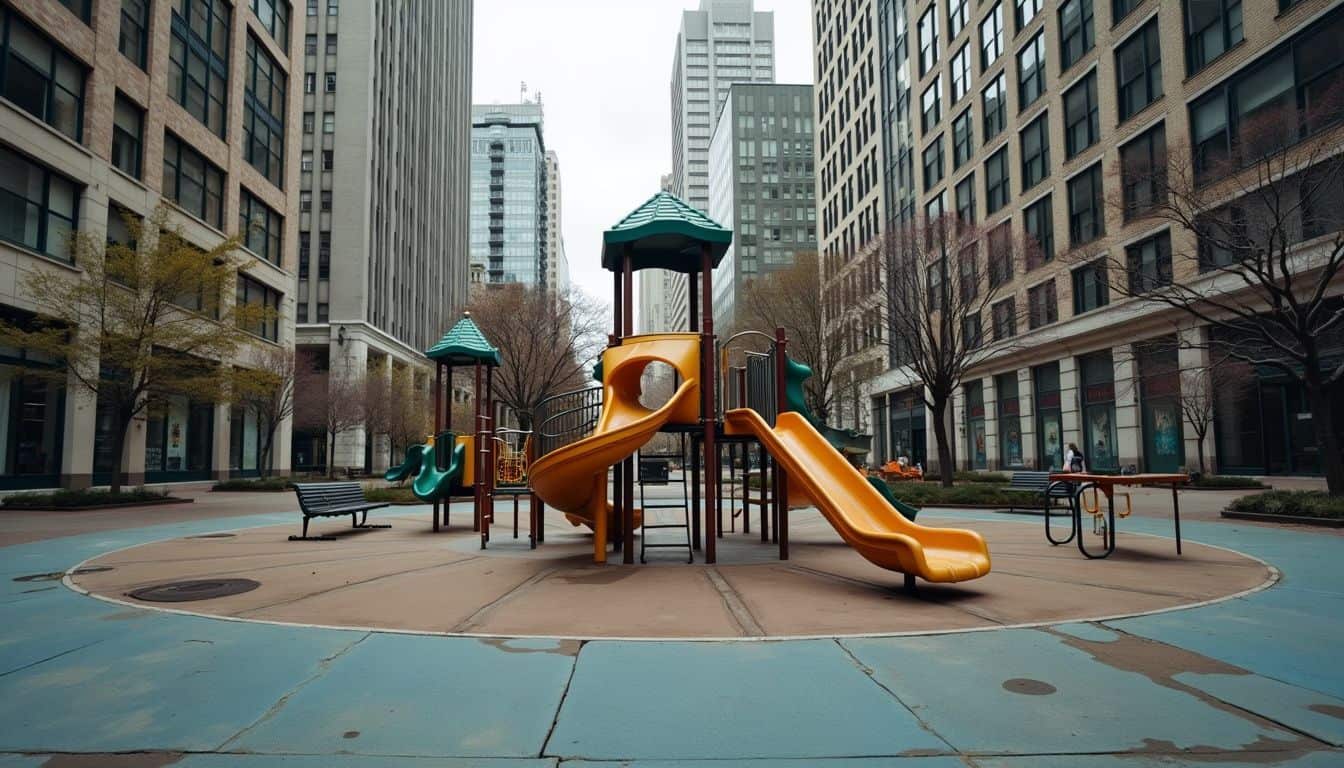Many parents feel shocked when they see daycare costs. The average yearly cost for full-time childcare is $9,589. This blog will explain why daycare is so expensive. We’ll reveal eight key reasons behind the high price tag.
Get ready to learn the truth about childcare costs.
Key Takeaways
Daycare costs average $9,589 per year for full-time care, driven by strict rules, high rent, and staffing expenses.
Caregiver-to-child ratio rules increase costs by 9-20%, while requiring lead providers to have a high school diploma can raise prices by 25-46%.
Location greatly impacts daycare costs, with rent in urban areas like Washington, D.C. pushing prices to $3,773 per month for two young children.
Staffing makes up 83% of a daycare’s monthly budget, with centers needing to offer competitive wages to attract qualified workers.
Government funding falls short, leaving families to cover most costs out-of-pocket, with childcare expenses taking up 8% to 19.3% of median family income.
Table of Contents
Understanding Regulatory and Compliance Costs

Daycare centers must follow strict rules to keep kids safe. These rules cost money and drive up prices for parents.
Implications of caregiver-to-child ratio regulations
 Caregiver-to-child ratio rules make daycare pricier. These rules say how many kids one worker can watch. Fewer kids per worker means more staff and higher costs. Studies show that easing these rules could cut prices by 9-20%.
Caregiver-to-child ratio rules make daycare pricier. These rules say how many kids one worker can watch. Fewer kids per worker means more staff and higher costs. Studies show that easing these rules could cut prices by 9-20%.
This would help many families, especially those with lower incomes.
Strict rules hit poor families hardest. They often can’t afford licensed care and turn to informal options. As a mom, I’ve seen firsthand how tough it is to find affordable care. It’s crucial to label kids’ items for daycare.
Using daycare labels helps avoid mix-ups and lost belongings.
Regulations aim to protect children, but they also drive up costs for families.
Necessity of licensing and ongoing compliance

Daycare centers must follow strict rules to stay open. These rules help keep kids safe, but they cost money. Centers need licenses to run legally. They also have to keep up with new laws and safety standards.
This means more paperwork and staff training. All these things add up and make daycare more expensive.
Licensing affects daycare prices a lot. Studies show that when lead providers need a high school diploma, prices can go up 25-46%. This rule aims to improve care quality. But it doesn’t always work that way.
Sometimes, it just makes care cost more without making it better. Daycare owners pass these costs on to parents. This is why many moms find daycare so pricey.
Insurance requirements
 Licensing and compliance lead to another key cost for daycares: insurance. Childcare centers must carry several types of coverage to protect against risks. Liability insurance guards against accidents or injuries on-site.
Licensing and compliance lead to another key cost for daycares: insurance. Childcare centers must carry several types of coverage to protect against risks. Liability insurance guards against accidents or injuries on-site.
Property insurance safeguards the building and contents. Workers’ comp covers staff injuries. These policies add up fast.
Insurance costs vary based on factors like location and center size. Urban areas often have higher premiums. Larger centers with more kids need more coverage. Some states require specific insurance types or amounts for licensing.
Centers may need extra policies for field trips or special activities. As a mom looking at childcare options, I’ve seen how these costs get passed on to families through higher rates.
Analyzing Location Factors

Location plays a big role in daycare costs. Rent in cities can be sky-high, driving up prices for parents.
Cost implications of high rent in urban areas
High rent in urban areas drives up daycare costs. In big cities, daycares pay more for space, pushing prices higher for parents. Rent often makes up a large chunk of a daycare’s expenses.
This hits families hard in places like Washington, D.C., where daycare for two young kids costs $3,773 per month on average.
Urban daycares also face other high costs tied to location. They may need to pay more for insurance, utilities, and staff wages in pricey cities. These added expenses get passed on to parents through higher fees.
As a mom who ran a small daycare, I saw firsthand how rent could eat up most of our budget each month.
Location is everything in real estate – and in daycare costs too.
Property maintenance expenses
Rent costs hit hard in cities, but property upkeep adds another layer to daycare expenses. Keeping a childcare space safe and clean isn’t cheap. Daycare centers must fix broken items fast, repaint walls often, and replace worn-out toys and furniture.
These tasks cost money and time.
Outdoor areas need care too. Playgrounds require regular checks and repairs to stay safe for kids. Inside, centers must update heating and cooling systems to keep children comfy year-round.
All these costs add up, pushing daycare prices higher for parents. Centers can’t skimp on upkeep without risking kids’ safety or breaking rules.
Exploring Staffing Challenges

Daycare centers face tough staffing challenges. They must pay high wages to attract skilled workers while also covering training costs.
Costs associated with recruitment and training
Daycare centers face big costs when hiring and training staff. They spend a lot on job ads, background checks, and interviews to find good workers. Once hired, new staff need training on safety rules, child care methods, and center policies.
This training takes time and money.
Centers must also keep up with ongoing training for all staff. They pay for workshops, classes, and certifications to meet state rules. With high turnover in child care jobs, centers often repeat this costly process.
Monthly payroll for a typical daycare tops $30,000, showing how much goes to staffing costs.
Finding and keeping good child care workers is like trying to fill a leaky bucket.
Need for competitive salaries to attract qualified staff
Recruiting skilled staff is costly, but keeping them is even harder. Daycares must offer good pay to attract and keep top talent. Salaries make up 83% of a daycare’s monthly budget.
This huge chunk goes to hiring and keeping the best teachers and caregivers.
Daycares compete with schools and other jobs for qualified workers. They need to pay fair wages to get great staff. In 2021, home-based providers only earned about $10.61 per hour.
This low pay makes it hard to find and keep good workers. Higher salaries help daycares hire skilled staff who can give kids the best care and learning.
Examining Operating Expenses

Daycare centers face steep costs for basic needs. They must pay for power, water, and supplies while also buying safe toys and learning tools.
Rising costs of utilities and supplies
Daycare centers face rising costs for utilities and supplies. Electric bills, water usage, and heating expenses keep going up. Centers must buy more cleaning products to meet health rules.
They also need to stock up on toys, books, and art supplies for kids.
Food costs for snacks and meals have jumped, too. Many centers now offer organic options, which cost more. Diapers, wipes, and other daily items add up fast. These rising costs force centers to raise their prices to stay open.
The cost of running a daycare is like a constantly moving target.
Investments in safety and educational equipment
Daycare centers must invest in safety gear and learning tools. This raises costs but keeps kids safe and helps them grow. Centers buy items like fire alarms, child-proof locks, and first aid kits.
They also need age-appropriate toys, books, and art supplies. These items aren’t cheap, but they’re vital for quality care.
Good equipment supports child development and meets regulations. Centers often update their supplies to stay current with best practices. They may add new tech like tablets for learning games.
Or they might get special furniture sized for small children. All these investments add up, pushing daycare prices higher for families.
Investigating Market Demand

Daycare prices rise when more parents need childcare. Limited spots in good centers drive costs up even more.
Effects of higher demand on prices
Higher demand for daycare services drives up prices. More parents need childcare as they return to work after the pandemic. This surge in demand puts pressure on existing daycare centers.
They often can’t expand quickly enough to meet the growing need. As a result, many centers raise their fees.
The U.S. Labor Department found a 6% jump in preschool and daycare costs recently. This increase hits families hard, especially those with tight budgets. Some parents may have to choose between work and staying home with their kids.
Others might seek cheaper, less ideal childcare options.
The rising cost of daycare reflects a market struggling to keep up with demand, says economist Jane Smith.
Issues with limited availability of slots
High demand for daycare often leads to a shortage of spots. This creates a big problem for many families. Finding care for infants and toddlers is especially hard. On average, there are over four babies for every licensed childcare slot.
This means many parents struggle to find a place for their child.
The COVID-19 pandemic made this issue worse. Many daycares closed or reduced their capacity. This left even fewer spots for families who need care. Parents of infants and toddlers face the biggest challenge.
They often end up on long waitlists or have to find other options. Some turn to family members or hire nannies. Others may need to change their work schedules or even quit their jobs.
Assessing Economic Influences

The rising cost of living affects daycare prices. Higher wages and inflation push up the costs of running a childcare center.
Impact of the rising cost of living on operational costs
Rising costs of living hit daycare centers hard. Rent, utilities, and supplies all cost more each year. These expenses force centers to raise their fees. Staff wages must also go up to keep good teachers.
This creates a cycle of higher costs for both centers and parents.
Daycare centers face tough choices in this climate. They must balance quality care with affordable prices. Some centers cut back on extras or raise class sizes. Others seek government help.
But many simply pass costs to families through higher tuition. This makes childcare a major expense for working parents.
Evaluating Parental Expectations

Parents want top-notch care for their kids. They expect daycare centers to offer extras like meals and longer hours.
Demand for high-quality, comprehensive services
Moms want the best for their kids, and that includes top-notch daycare. They seek places that offer more than just basic care. These centers provide early learning programs, healthy meals, and fun activities.
Such high-quality services come at a price. Centers must hire skilled staff and buy good materials to meet these needs. This drives up costs for both providers and families.
Many parents also look for extra perks in daycare. They want flexible hours, bilingual teachers, or special classes like music or art. These added features make daycare more expensive.
Centers that offer these services must charge more to cover their costs. The next factor that affects daycare prices is parental expectations for longer hours and additional offerings.
Expectations for additional offerings like meals and extended hours
Parents want more from daycare than just basic care. They expect meals and longer hours to fit their busy lives. This adds to the costs of running a daycare. Feeding kids takes money for food and staff to prepare it.
Staying open late means paying workers for more hours. These extras make daycare pricier, but many families need them to balance work and childcare.
I’ve seen firsthand how these added services impact costs. At my friend’s daycare, they serve breakfast, lunch, and snacks daily. They also stay open until 7 PM for working parents.
While convenient, it requires more staff and resources. This pushes up fees for all families, even those who don’t use extended hours. Balancing parent needs with affordable care is an ongoing challenge in early childhood education.
Government Subsidies and Funding

Government funding for daycare often falls short. Many centers rely on parents to cover most costs.
Challenges of inadequate public funding
Public funding for daycare falls short. Many families struggle to afford care, even with help. The Credit for Child and Dependent Care hasn’t stopped prices from rising. Daycare costs now eat up 8% to 19.3% of median family income.
This puts a huge strain on working moms.
I’ve seen firsthand how hard it is for parents to find affordable care. As a former daycare teacher, I watched families juggle bills to pay for childcare. More government subsidies could ease this burden.
But for now, the lack of public funds keeps pushing daycare costs higher. Let’s look at how parental expectations affect prices.
Dependence on private payment
Lack of public funds pushes daycare costs onto families. Most parents pay out of pocket for childcare. This creates a heavy burden, especially for low-income households. In all states, childcare costs top 7% of median income for married couples.
Many families struggle to afford quality care on their own.
Private payments keep daycare centers running. Without enough government support, centers rely on tuition fees from parents. This model makes it hard to keep prices low while paying staff fair wages.
It also limits access for families who can’t afford high fees. More public investment could help make daycare more affordable for all.
Future Outlook

Daycare costs will likely keep rising. New rules and higher wages for workers may push prices up even more.
Trends in daycare pricing
Daycare prices keep going up faster than other costs. In big U.S. counties, parents pay about $17,000 a year for infant care. This hits low and middle-income families hard. Many struggle to afford quality care for their kids.
Some look at other options compared to Montessori schools, which can be pricey too.
Experts think daycare costs will keep rising. More rules and higher wages for workers drive up prices. The job market is tight, so centers must pay more to keep good staff. Parents want the best care, but often can’t pay what it really costs.
This leaves many families in a tough spot.
Anticipated regulatory changes
Daycare rules might change soon. Experts think new laws could affect costs and quality. Some people want fewer rules to make daycare cheaper. Others say we need more rules to keep kids safe.
The government might change how many kids each worker can watch. This could make daycare less expensive, but some worry it might not be as good. New laws might also change what daycare workers need to learn.
This could make it harder or easier to find good staff.
Money is a big part of these changes. Some want the government to pay more for daycare. This could help parents, but it costs taxpayers more. Others think the free market should set prices.
They say this would make daycare better and cheaper over time. No one knows for sure what will happen, but these changes could affect many families.
People Also Ask
Why is daycare so expensive in places like New York?
Daycare costs are high due to many factors. These include high salaries, rent, and insurance costs. In areas like Tribeca or Riverdale, prices are even higher. Baumol’s cost disease also plays a role, making services more costly over time.
How do childcare subsidies affect daycare costs?
Childcare subsidies can help lower costs for families. They’re meant to make care more affordable, especially for the poorest. However, budget cuts often limit these programs. This leaves many families struggling to pay for quality care.
What impact does occupational licensing have on daycare prices?
Occupational licensing raises costs. Childcarers need certifications like the Child Development Associate. This increases labor market barriers. It also drives up wages and, in turn, daycare prices.
Can employers help with daycare expenses?
Some employers offer childcare benefits. These may include on-site creches or subsidies. Such perks can help with employee retention. They also make it easier for parents to work. But not all companies can afford these options.
How does the concept of positive externalities relate to daycare?
Daycare provides positive externalities. This means it benefits society beyond just the families using it. It helps child development and allows more parents to work. This is why some argue for universal child care or more government support.
Are there alternatives to traditional daycare centers?
Yes, alternatives exist. Some families use au pairs or rely on a stay-at-home parent. Others form cooperatives or use family members. In some areas, community programs offer afterschool care. These options can be cheaper but may not suit everyone’s needs.
References
https://www.cato.org/regulation/fall-2018/regressive-effects-child-care-regulations
https://www.mercatus.org/students/research/working-papers/regulation-and-cost-child-care
https://www.ncbi.nlm.nih.gov/pmc/articles/PMC4076055/
https://ktla.com/news/child-care-costs-more-than-rent-across-100-largest-us-metros/ (2024-09-19)
https://www.rasmussen.edu/degrees/education/blog/why-is-child-care-so-expensive/ (2021-10-25)
https://www.npr.org/transcripts/1153931108
https://www.zerotothree.org/resource/good-question/why-is-child-care-so-expensive/ (2024-03-20)
https://www.cbsnews.com/boston/news/child-care-costs-rising-massachusetts/ (2023-08-24)
https://www.cato.org/commentary/why-childcare-expensive (2023-09-14)
https://www.americanprogress.org/article/true-cost-high-quality-child-care-across-united-states/ (2021-06-28)
https://www.census.gov/library/stories/2024/01/rising-child-care-cost.html
